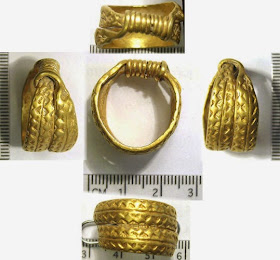Pages
▼
British Musuem: Viking Gold
A gold Viking pendant in the form of 'Thor's hammer'. The pendant is in the form of a double-headed hammer with an elongated pentagonal head. The head is rectangular in cross-section. From the centre of the head extends an integral tapering rectangular-sectioned shaft. The terminal of the shaftis narrowed to form a suspension loop. Both faces of the axe are decorated with punched motifs resembling quatrefoils or perhaps miniature axes.
A gold finger-ring dating to the Viking period. The ring is composed of three tapering, square-sectioned rods twisted together, which are thicker at the front, while at the back the ends are hammered flat together into a plain, narrow band. Gold rings of twisted type from the British Isles and Scandinavia are dated from the late Saxon/Viking periods into the early Middle Ages, from the late 9th century into the 12th century.
An Early Medieval (Viking) gold finger ring dating from the late 9th-10th century. It is made from a strip of gold which tapers to wire terminals which are wound around each other at the back of the hoop. The bezel of the ring is the widest part of the strip, and is an elongated lozenge.
A Viking gold ring ring which consists of a double-banded hoop made from a slightly concavo-convex strip with the ends drawn into wires at the back of the hoop, which are then tightly wound round a constricted section of the strip.




